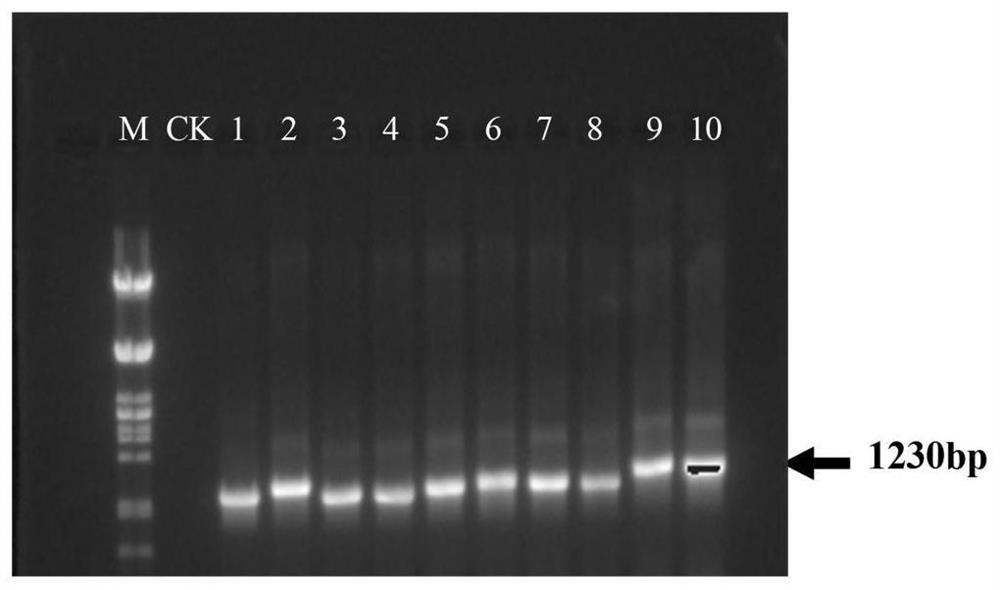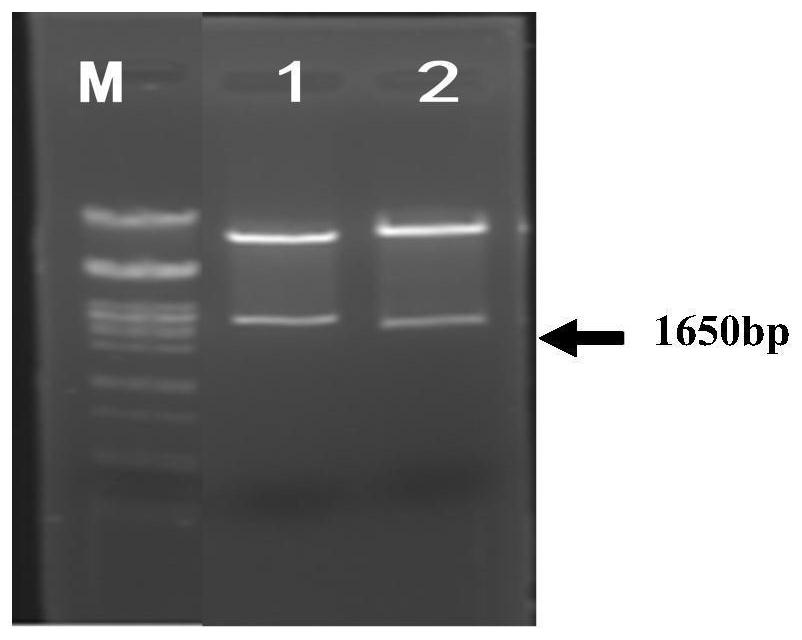A method for improving plant resistance to insects and its plant expression vector
A kind of ability and insect technology, applied in the field of improving plant insect resistance, method and plant expression vector, can solve the problems of poor stability, high price, difficult research and application of 5-ALA, etc., and achieve the goal of reducing use and production cost Effect
- Summary
- Abstract
- Description
- Claims
- Application Information
AI Technical Summary
Problems solved by technology
Method used
Image
Examples
Embodiment 1
[0029] Cloning of embodiment 1, 5-aminolevulinic acid synthase gene
[0030] 1) According to the sequence registration information in NCBI, design 5-ALAS gene-specific PCR amplification primers and introduce restriction sites. The primer sequence is as follows: 5'primer: 5'-GGTACCATGGATTACACCAAGTTCTTC-3'The part in italics is the KpnI restriction site point
[0031] 3' primer: 5'-GGATCCTTATTCCGCAGCGAGCGGCTT-3' italic part is BamHI restriction site
[0032] 2) Preparation of the photosynthetic bacterium Rhodoblastus acidophilus PSB-8 genome: take the photosynthetic bacterium Rhodoblastus acidophilus PSB-8 strain, inoculate the liquid medium at a ratio of 1:100, 30°C, 2500LX light Cultured for 7 days. Take 10ml of bacterial liquid, centrifuge at room temperature at 12000rpm for 5min to collect bacterial cells. After dissolving with 500 μl TE buffer, add 30 μl 10% SDS and 3 μl proteinase K, mix well, and incubate at 37°C for 1 hour. Add 100 μl of 5M NaCl, mix well, add 80 μl ...
Embodiment 2
[0035] Embodiment 2, the construction of the plant expression vector of phloem-specific promoter rolC and 5-aminolevulinic acid synthase gene
[0036] The construction strategy of the plant expression vector pCAMBIA1300 with phloem-specific promoter (rolC promoter) and 5-aminolevulinic acid synthase gene (ie 5-ALAS gene): rolC promoter: ALAS: rolc teminator is as follows figure 2 shown. The specific experimental steps are described as follows.
[0037] 1) Construction of the intermediate vector pCAMBIA1300:ALAS: the pGEM-T-Easy:ALAS recombinant plasmid and the pCAMBIA1300 plasmid (purchased from Cambia institute from Australia) were double-digested with restriction enzymes KpnI and BamHI, respectively. The 5-ALAS fragment excised from the pGEM-T-Easy:ALAS recombinant plasmid and the large fragment after pCAMBIA1300 double digestion were recovered by electrophoresis and gel slicing. The recovered fragment was transformed with T4 DNA ligase at a ratio of 1:3 (molar ratio), an...
Embodiment 3
[0042] Example 3. Plant expression vector pCAMBIA1300: rolC promoter: ALAS: rolc teminator introduced into Agrobacterium
[0043] Competent cells of Agrobacterium EHA105 were prepared, and the above-constructed plant expression vector pCAMBIA1300:rolC promoter:ALAS:rolc teminator was introduced into Agrobacterium EHA105 by the heat shock transformation method, and the transformation was screened using the culture medium of rifampicin and kanamycin son. Put the Agrobacterium competent cells taken out at -70°C on ice for about 5 minutes. After thawing, add 1 μl of plasmid and mix with the Agrobacterium competent cells, let stand on ice water at -20°C for 30 minutes, and quickly transfer to 37°C Heat shock in water bath for 30min, add 800μl liquid SOC medium, recover at 28℃, 200rpm for 3-5hrs, take 200μl evenly coated on YEP plate containing 50μg / ml kanamycin and 50μg / ml rifampicin, incubate in dark at 28℃ for 48hrs , Perform colony PCR screening to obtain positive transformants...
PUM
 Login to View More
Login to View More Abstract
Description
Claims
Application Information
 Login to View More
Login to View More - R&D
- Intellectual Property
- Life Sciences
- Materials
- Tech Scout
- Unparalleled Data Quality
- Higher Quality Content
- 60% Fewer Hallucinations
Browse by: Latest US Patents, China's latest patents, Technical Efficacy Thesaurus, Application Domain, Technology Topic, Popular Technical Reports.
© 2025 PatSnap. All rights reserved.Legal|Privacy policy|Modern Slavery Act Transparency Statement|Sitemap|About US| Contact US: help@patsnap.com



